Namak Para (plural: Namak Pare) are scrumptious crispy fried, spiced and savory bites made with whole wheat flour, spices, seasonings and oil or ghee. These tit-bits can be touted as the salted cousin of Shakkarpara, both of which form the quintessential duo of Diwali treats, especially across North India. in this post, I have shared a Punjabi style Namak Para recipe that you can easily make during your Diwali festivities or even enjoy as a snack during your tea or coffee time.
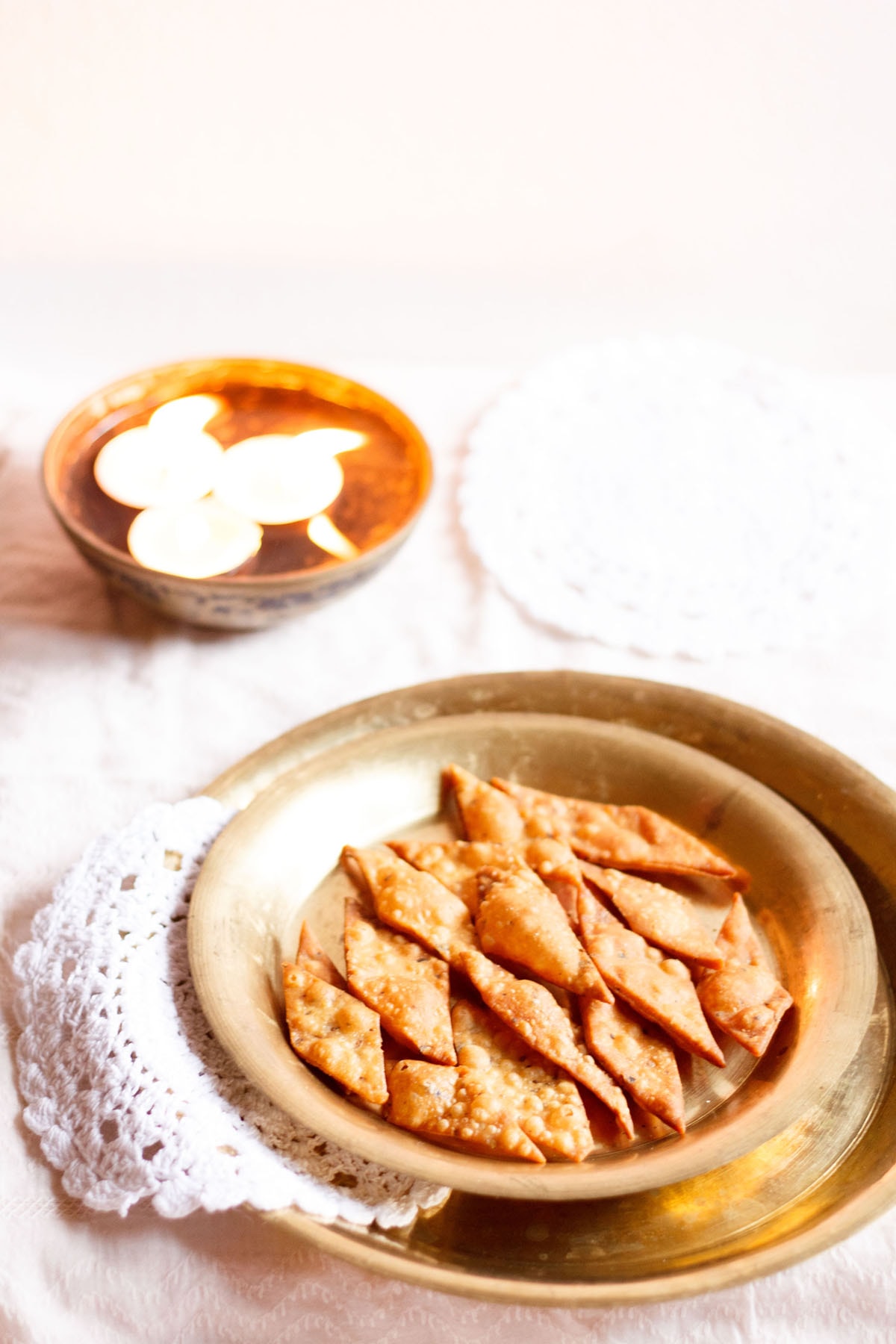
What is Namak Para
It is obvious from the name Namak Para that this festive treat has ‘namak,’ which is salt in English, as the main seasoning. This is also the reason for it being termed as a savory snack.
Along with this, the suffix ‘para (plural: pare)’ refers to ‘pieces.’ When put together, the name literally means ‘salty or salted pieces’ or even ‘salty bites.’
Basically, the Namak Para Recipe is a spiced and seasoned pastry dough, traditionally made of whole wheat flour, all-purpose flour or a combination of both. This is then rolled out and cut into strips, diamonds or squares.
While the classic cooking method of these include them being deep-fried, these days a lot of people also air-fry or bake this snack for health concerns.
Just like many other snacks and sweets having regional variations, Namak Para also is made in a variety of ways across the Indian subcontinent. This bite-sized snack can be crispy, flaky or spicy, but is essentially savory in all its variants.
For instance, it is referred to as ‘nimki’ in West Bengal. The Maharashtrian version is known as Shankarpali. Also, the sweet version of the same is the shakkarpara.
About This Recipe
This tasty snack, also known as Savory Diamond Cuts is very easy to prepare and does not require many ingredients.
Most of your time will be spent frying them as they need to be fried in batches. This Namak Para Recipe makes for a crunchy munchy snack that also puffs up while frying.
You have to just knead a firm dough, which is spiced with carom seeds (ajwain), crushed black pepper, cumin seeds, and seasoned properly with salt (namak).
Then, roll and cut the dough into the choice of shape you want (I usually prefer diamonds) and deep-fry to a perfect golden brown.
The recipe of this Namak Para contains both whole wheat flour and all-purpose flour for crispiness. However, you can make them with one of the two flours, instead. I prefer to use whole wheat flour wherever possible.
You can make these in bulk, store in an air-tight container and enjoy with tea for the next few weeks. They are excellent tea-time snacks as well as for festive occasions like Diwali and Karwa Chauth.
How to make Namak Para
Make Dough
1. Mix all the ingredients for the pastry dough listed below and knead to a firm and stiff dough. Cover the dough with a moist kitchen cotton towel and set aside for 30 minutes. Add water in parts when kneading the dough.
- 1 cup whole wheat flour (atta)
- 1 cup all-purpose flour (maida)
- 1 teaspoon carom seeds (ajwain)
- 1 teaspoon crushed black pepper
- ¼ teaspoon baking soda
- ½ teaspoon salt or as required
- 2 tablespoons oil or ghee – if using oil, use a neutral oil
- ½ to ¾ cup water or as needed
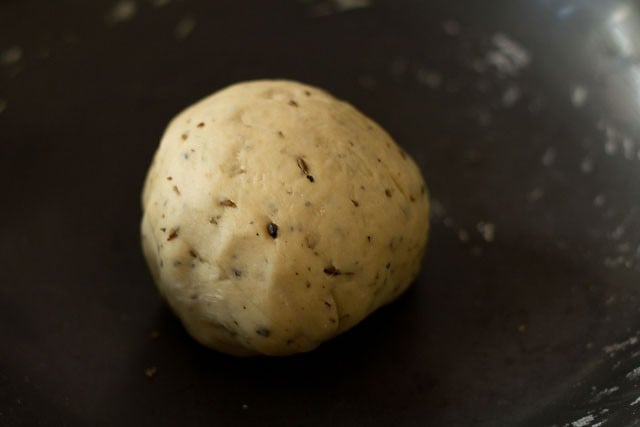
2. Pinch a medium-sized ball from the dough. Roll it to a neat smooth ball between your palms. Place it on a lightly dusted board. Sprinkle a bit of flour on top of the dough ball.
Tip: Dusting the surface with flour prevents the dough from sticking to the board when rolling.
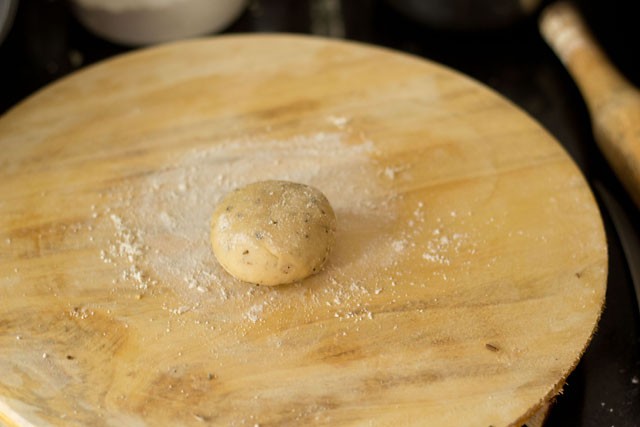
Make Namak Pare
3. Using a rolling pin, roll the dough and make sure it is not too thick or thin, about 3 to 4 mm in thickness.
Also, ensure that you have lightly dusted the dough and board. If you prefer, opt out of dusting the dough and board with flour.
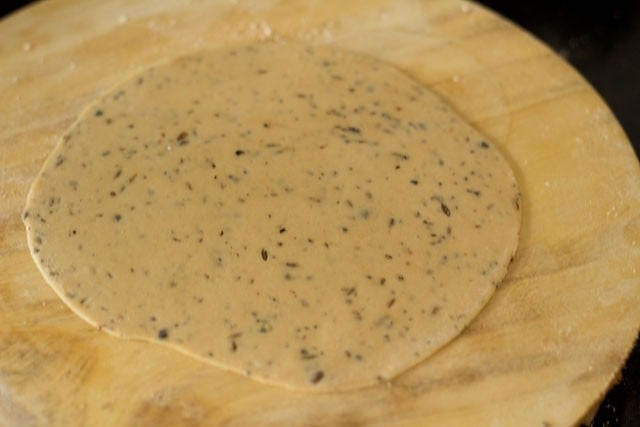
4. Use a serrated knife to slice diagonal cuts on the rolled dough. The dough should have equal-shaped diamonds.
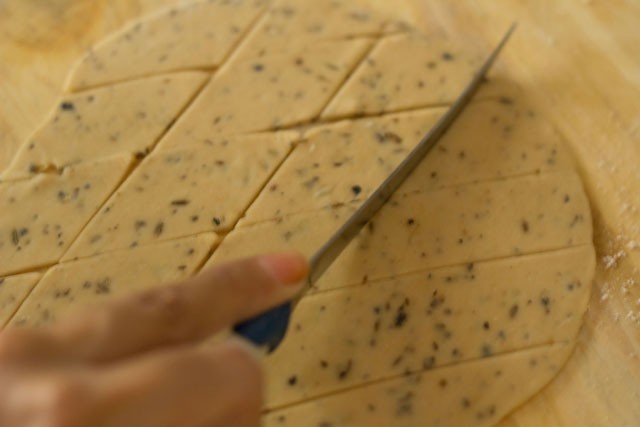
5. Add the diamond-shaped dough to a plate and cover them with a cloth. Keep aside for frying later.
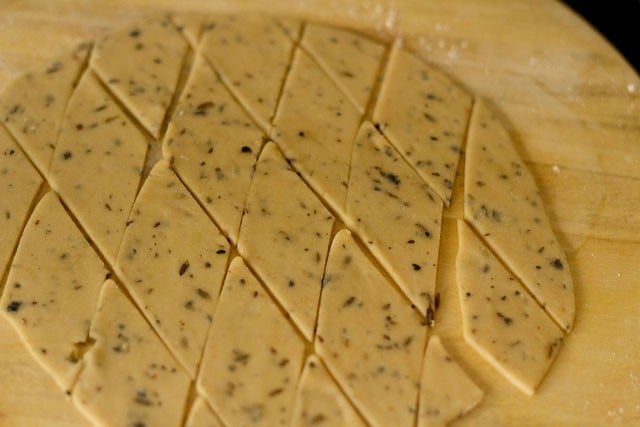
Fry Namak Para
6. Heat oil for frying in a kadai (wok). Keep the heat to medium to medium-high. The oil has to be moderately hot.
Gently and carefully place some Namak Para diamonds in the hot oil. Make sure not to make the pan over crowded with the pieces.
Turn over with a slotted spoon when one side has become crisp and golden. Fry the second side and turn over again when golden. Turning over a few times, fry Namak Pare for even browning.
Tip: Make sure the oil is not too hot as you don’t want the Namak Para to burn.
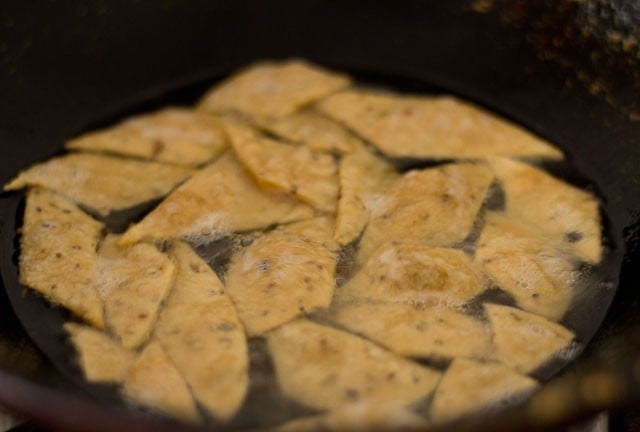
7. Fry until golden-brown and crisp. Drain them on a paper towel to remove excess oil. Fry the remaining batches this way.
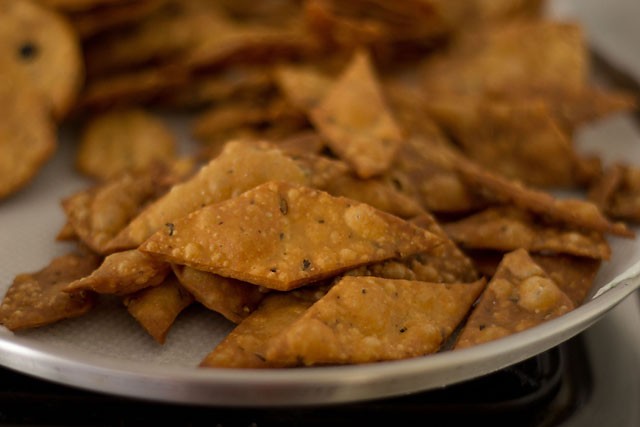
8. As soon as they cool, store in an air-tight jar or container. Serve Namak Pare with a cup of tea or as a snack.
These keep well for a couple of weeks in an air-tight container at room temperature.
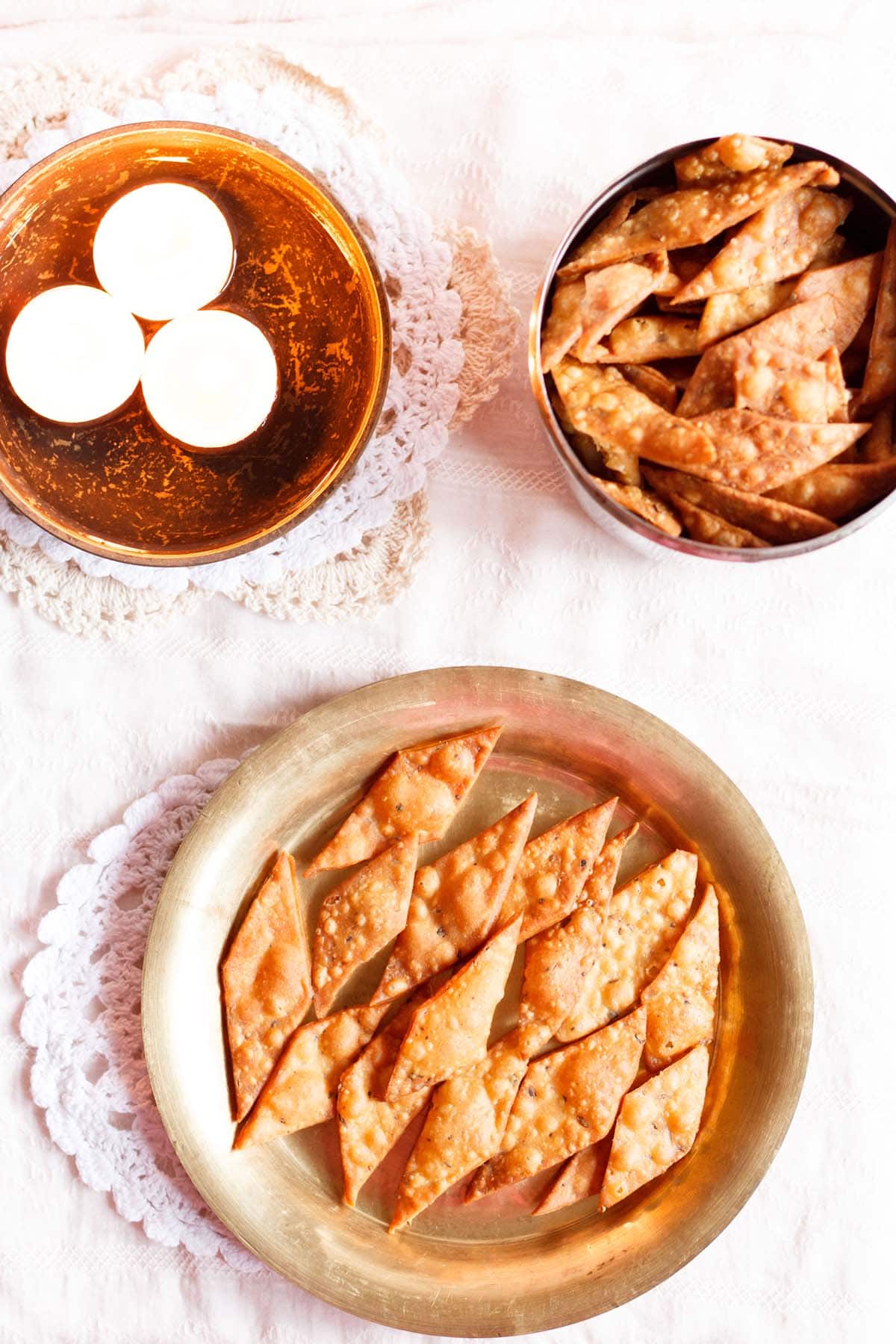
Expert Tips
- Flour: For this recipe, I have used whole wheat flour and all-purpose flour. But you can use any one or the other, depending on your preference. I typically opt for whole wheat flour because it is a healthier option and the results are just as amazing.
- Dough: Make sure that your dough is the right texture to achieve the perfect results. The dough should not be too dry, as this may cause it to crack while rolling and will also make the texture dense. If the dough is too wet, then the Namak Para will be soft. To achieve a nice stiff and firm dough, add water in parts while kneading.
- Oil: I normally fry this snack in peanut or sunflower oil. Peanut oil adds a delicious nutty flavor while sunflower oil has more of a neutral taste. Feel free to use any of these 2 oils for the perfect results.
- Frying: Ensure to deep-fry these Savory Diamond Cuts in moderately hot oil. A less hot oil will make it absorb too much oil. If the oil is too hot, the snack will brown faster from outside. But inside will still be undercooked.
- Variations: This is a versatile snack that has a variety of flavors and textures. It can be spicy, herby, flaky or crispy. Depending on the amount of fat used in the dough, the resulting texture can be flaky or have a crispy hollow structure.
Add spices and herbs like dried fenugreek leaves (kasuri methi), crushed fennel seeds (saunf), nigella seeds/onion seeds (kalonji), asafoetida (hing), turmeric powder and red chili powder to make different yummy variations. - Baking: To make a baked version of the Namak Para Recipe, add 3 to 4 tablespoons of oil or ghee when making the dough. Keep the raw cut dough pieces on a baking tray. Preheat oven at 180 degrees C/356 degrees F for 15 minutes. Bake at the same temperature for 20 to 25 minutes or until crispy and golden. If needed, turn over the pieces halfway, through baking.
- Scaling: You can scale the recipe to make a smaller or larger serving.
FAQs
This may be because there is not enough water in the dough. When the dough is too dry, it will crack. So, to avoid this, you need to add more water and knead until the dough is smooth.
In this particular recipe, you can use baking soda and baking powder interchangeably and still get amazing results. Add about ½ teaspoon of baking powder instead of baking soda.
For the Namak Pare to be crispy, the dough must be stiff and firm, and not too soft. It should also be fried on a medium heat. The longer you fry, the crispier they will become.
Namak Pare will still taste just as good without baking soda. But adding baking soda gives it a light and crispy texture.
More Festive Snack Recipes To Try!
Evening Snacks
Sweets Recipes
Evening Snacks
Evening Snacks
Please be sure to rate the recipe in the recipe card or leave a comment below if you have made it. For more vegetarian inspirations, Sign Up for my emails or follow me on Instagram, Youtube, Facebook, Pinterest or Twitter.
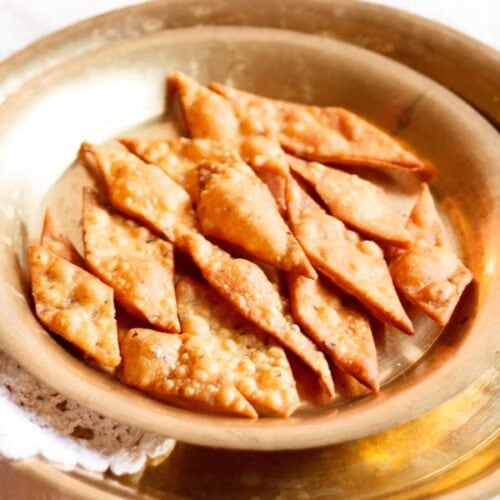
Namak Para | Namak Pare (Salty Diamond Cuts)
Ingredients
- 1 cup whole wheat flour (atta)
- 1 cup all purpose flour (maida)
- 1 teaspoon carom seeds (ajwain)
- 1 teaspoon crushed black pepper – optional
- 1 teaspoon cumin seeds – optional
- ¼ teaspoon baking soda
- 2 tablespoons oil or ghee – I used sunflower oil
- ½ to ¾ cup water or as needed
- ½ teaspoon salt or as required
- oil for deep frying, as required
Instructions
Making dough
- Sieve the whole wheat flour, all purpose flour, baking soda and salt together.
- Add the carom seeds, crushed black pepper, cumin seeds and salt. Mix these spices and seasonings with the sifted ingredients.
- Add the oil or ghee. Add water in parts and start to knead the dough.
- The dough should not be soft, but firm and tight. Cover and set aside the dough to rest for 30 minutes. You can either cover the bowl with a lid or place a moist kitchen towel on the dough.
Making namak pare
- Take medium sized balls from the dough. Roll them to a neat round ball between your palms. Place one ball on a lightly dusted floured surface or rolling board.
- With a rolling pin, roll into a disc or round neither too thin nor too thick and about 3 to 4 mm thick.
- With a serrated knife cut criss cross patterns on the rolled dough.
- Remove the diamond shaped patterns and deep fry them in hot oil till crisp and golden browned.
- Keep the cut pieces of dough covered with a kitchen towel, so that they do not dry out.
- Drain them on paper napkins to remove excess oil. Fry the remaining namak pare or diamond cuts in batches.
- Once they cool at room temperature, then store them in an airtight jar. These keep well for a couple of week when stored in an air-tight container or jar.
- You can serve Namak Pare with tea or as a snack.
Notes
- Add water in parts when kneading to make a stiff and firm dough. Do not make it soft like a roti or chapati dough.
- You can opt to use only all-purpose flour or only whole wheat flour to make the dough.
- Deep fry in a moderately hot oil until crispy and golden. A lesser hot oil will make the namak para absorb too much of oil. If the oil is very hot, the namak pare will get browned faster from outside and the inside dough can be undercooked.
- Leave out the spices for making only a salted version of namak para. Alternatively you can add ground spices and herbs like red chilli powder, turmeric powder, garam masala powder, crushed fennel seeds, nigella seeds and dry fenugreek leaves.
- If you want to bake namak pare, add 3 to 4 tablespoons oil or ghee to the dough. Place the raw cut dough pieces on a baking tray. Preheat oven at 180 degrees Celsius for 15 minutes. Bake at the same temperature for 20 to 25 minutes or until golden and crispy. Turn over the namak pare pieces if needed halfway through the baking.
- This recipe can be scaled to make a smaller serving or a larger serving.
Nutrition Info (Approximate Values)
This Namak Para recipe from the archives, first published on November 2012 has been republished and updated on October 2023.
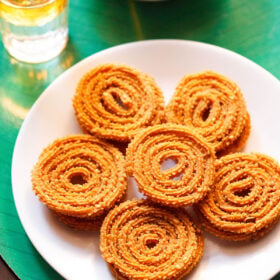
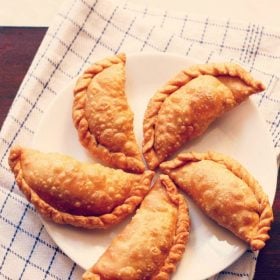
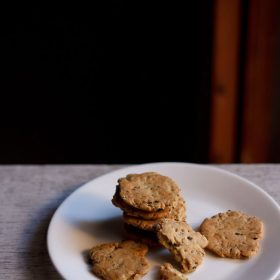
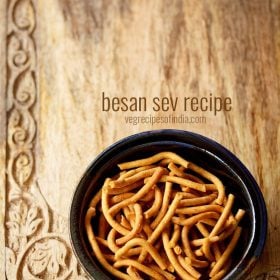








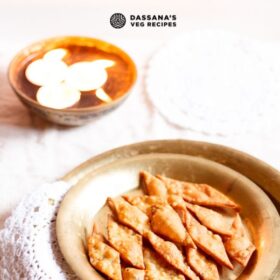
Why is the Roti I’m rolling breaking up into cracks all over. Please advise. Thanks.
there is less water in the dough and thus the dryness leading to cracks when rolling. so you need to add more water and knead to a smooth dough.
Nice recipe ..thank for Post..I am fan of all your food…u know maharashtrain dishes well…great thanks
Tulsi K
thanks tusli. glad that the recipes are helping you. happy cooking.
नमक परा रेसिपी शेयर करने के लिए आपका बहुत धन्यवाद
Welcome Seema
Hi Dassana,
Your website is my go to for every single recipe! 🙂 thanks so much for helping out lost souls like me 😉 a quick question, can baking powder be used instead of baking soda in recipes like this? Are B. Soda & B. Powder interchangeable?
Mucho gracias in advance!
thanks nishta. in recipes like these baking soda and baking powder can be used in place of each other. however in cakes, baking soda cannot be replaced with baking powder but vice versa is possible.
Thanks so much 🙂 my namak pare were okay but had a bitter aftertaste. Do you think kneading the dough with milk or sugar water can help eliminate the slight bitter aftertaste?
welcome nishta. i am wondering why the bitter after taste. which oil you used for kneading. sometimes sesame or peanut oil get give a bitter after taste. even ghee gone rancid can give a bitter taste. if the bitter taste is due to oil or ghee, then kneading with milk or sugar water won’t make any difference. hope this helps.
Which oil or ghee do u prefer for this recipe. Will refined go good ?
i usually use peanut oil or sunflower oil for frying. for adding in dough, i use sunflower oil or ghee. you can use refined oil also both to add in dough as well as frying.
Hi dassana,
The namakpaare came out very tasty and crispy! Thanks for yet another awesome recipe!
You are too good ????????
Welcome Pooja. Glad to know that you liked the namak pare recipe.
Hi, I am a huge fan of your blog,and the receipes that I try out from your blog are enjoyed by my family.need your advise on my question…I made namak pare as your receipes, but when i frief them in hot oil, it was not crispy ..It was very soft..Not sure where I would have gone wrong…But taste was nice..Can you please help?
Eagerly waiting for more receipes!!
.
thanks akshata. the namak pare dough has to be firm. the dough should not be soft. if the dough is soft, then the namak pare will be soft. also fry at medium flame. if you fry them for a longer time then they become more crisp. hope this helps.
Hi Dasanna,
Is it necessary to use baking soda.
will the namak pare come out well without baking soda.
waiting for ur reply.
thanks.
deepa, baking soda makes the namak pare more light as well as crisp. you can skip if you want. the texture will still be good.
Hi Dassana Ji..Can I use only maida instead of both maida and atta?
Dimpi, you can use only maida.
can u plz tell me how much salt to add approximately.
hina, you can add 1 teaspoon salt for a light salty taste. 1.5 teaspoon will give some more salty taste.
Hi dasanna, I am going to make this for the first time ,n I wanna know whether I can use four cups of whole wheat flour to two cups of all purpose flour?! There will be no change in the flavour know if I use the above combination?! Pls guide
anuradha, you can use. but also increase the amount of spices proportionately. not much change in the flavor texture.
Thanks dear but just seen ur reply I tried ur recipe with the same amounts n also tried totally with all purpose flour n both came out very good 🙂
welcome anuradha and good to know. thanks for sharing.
Thank You Dassana. Going to try this Diwali.. I am sure it will turn out to be fabolous. I have great trust in your recipes and when trying something new, I check ONLY your site. You are doing a great job and you have absolutely no idea that how much I am dependent on your website. Keep up the good work. Thanks a ton!
we are very pleased to know this soumya 🙂 thanks a ton for your kind, encouraging and honest words. god bless you.
Hi Dassana,
First of all i wanted to say – Great Job. As a woman I am proud of you and your work. The second thing i want to say is that your recipes are great!!! I will give you my reasons for the same. I am a big foodie and most of my day goes in planning what to eat :). Also i love cooking, and have been doing it has a hobby right from my early teens. Now I cook for my family and love trying new recipes. I have tried many books and many websites for new recipes since 2011. Frankly most of them dont work or turn out that great. I always blamed myself – maybe i wasnt following the recipe correctly. But then i started coming across your website everytime i search for something – especially over the last few months. I gave a few of your recipes a try – and it turned out amazing!!! Every thing i tried from your website has come out so fabulous that i am addicted to you. I tried Hyderabadi biryani, modak, trifle pudding, etc. You make them so easy and simple and with the perfect taste. i wanted to write to you about this for a long time and finally am doing it now. Now its Diwali time, and am going to make diwali goodies from your blog!! Thanks a ton. Hope you continue to make a success of your website!!!
thank you very much vidya. same here for me on planning. i plan everyday what to cook the next day. we share the same love for food and cooking 🙂
when i try recipes from elsewhere, even i blame myself thinking i must have done something wrong. its like how can the chef or book go wrong. i have tried many recipes in my teens from magazines and cookbooks. some turned out well and some did not. its basically the proportions of the ingredients, the details that should go in a recipe and this makes the difference.
i do try to make them simple and easy, but honestly speaking its not simple and easy at times. probably as i am more organized, there is some ease and less clutter in the workspace while i cook. thank you again and wish you a happy and prosperous diwali.
I tried this and my kids like it very much.
thankyou srilakshmi 🙂 pleased to know your kids liked them.
I like your receipes. It was wonderful. I see this first time can I make Namak pare in otg oven.
thanks poonam. you can make namak pare in an OTG oven. you can have a look at this recipe of sweet shankarpali (similar to shakkar pare) where i have shown the baked as well as the fried version.
need instant healthy recepies
Hi, I made this Namakparreh with 1 cup APF and 1 cup wheat flour, when I fried they came very but after sometime even though I covered they became very soft and mushy and no more crispy. Can anybody tell the reason?
Thanks
you covered meaning, you kept in an air tight jar. they have to be kept in an air tight box or jar, otherwise they become soft.
hi sukanya,
you should cool them first and then store in air tight container. If you store them hot in an air tight container then it will become soft.
thanks aparna for your response of looking it the other way around. rightly said 🙂
add some nigella seeds and see the difference in taste
thanks for the tip.
Namakpaaraz look lovely. Ajwain tastes great in them.In my country its a tradition to serve namakpaaraz along with sweet colourful boondis.
the combination of namakpaare with boondi must be so yum.
Hi dassana…
We make these paare every year fr diwali…
i tried it wid peppr last week …. It ws just awesome!!!
dat peppr in betwn…. sumwer ..
really nice
😀
thanks prutha.
dassana i should say im not indian.im iranian.but i like indian spicy foods .how can u eat so hot foods??????u add 3 kind of peper to one food.
hi setayesh. indians are used to eating spicy food 🙂
there is only one hot spice added to namak paare and that is black pepper. ajwain/carom seeds is a warm spice but not hot on the tongue. cumin is not hot at all. all these three spices bring the best of flavors and taste in the namak paare and they are used sparingly in the recipe.
hi dessana
i cooked namak paare today.it was very very yummy.i like it very much.thank uuuuuuuuuuuu.but i think its full of kallereis.:)any way i thank u very much
thanks setayesh for trying the recipe. it is indeed full of calories but once in a while it is ok.
gorgeous namak paare dassana! they remind me of my mom’s paare. there would loads of different mathris and such all through diwali:) dont stress. take your time.. Diwali will come next year too! all the best for the move, Happy diwali!
thanks richa 🙂
going to try this diwali 🙂
xx
hey do try sreebindu and give the feedback if possible.
I love that you give diwali festival feel to photos. Namak pare looks very delicious. I always love crispy pare over flaky one.
i like both the crispy as well as flaky ones.
Namak Paare looks delicious…I always use APF..adding wheat to it sounds gud compared to APF alone…
these look perfect and crispy Dassana, loved the photos too :), I wish I had some of these utensils too.
you know what you have to do to get those plates 😉
Looks very crispy. We make both namak para and shakkar para during diwali. I hope I get time to make it this diwali.